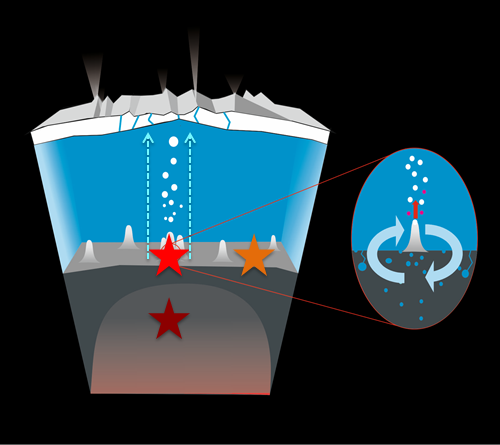Thermochemical modelling of the subsurface environment of Enceladus to derive potential carbon reaction pathways
- Open University, School of Physical Sciences, United Kingdom of Great Britain and Northern Ireland (rachael.hamp@open.ac.uk)
Introduction
The subsurface environment of Enceladus is potentially habitable: there is a global subsurface ocean [1], energy from hydrothermal activity [2] and bioessential elements [3]. Carbon, as a fundamental bioessential element, is critical for life, so understanding how it is processed within the Enceladus environment is crucial in assessing this moon’s potential habitability. Evidence from the south polar plumes suggests that carbon is likely to be bound within the silicate interior [4] and liberated through water-rock (silicate-ocean) interactions.
Methods
We have undertaken thermochemical modelling (CHIM-XPT) [5] of these interactions and tested different hypotheses for the formation of Enceladus. Both models reacted the silicate interior (with a CI chondrite composition [6]) with a fluid representative of the subsurface ocean: model 1) a dilute sodium chloride solution, based upon the assumption that the subsurface ocean originated as almost pure water [7]; model 2) a solution with a cometary composition (using data collected from 67P [8]), based upon the assumption that the ocean originated from melted cometary ice [9]. We have explored the full temperature and pressure ranges anticipated at the rock-water interface [2]. We have modelled the rock-water interactions: at the rock-water interface in the areas of hydrothermal activity; within the silicate interior, and in cooler areas of the ocean floor.
In addition, we have run thermochemical models to cool the subsurface ocean fluid as it ascends from the ocean floor to the water-ice boundary; these results should be more comparable to the Cassini observations, as the plume material emanates from the ocean surface.

Figure 1 - A cross section of the subsurface of Enceladus' South Polar Region, highlighting the area of study. The stars represent the different regions of study for the water-rock interaction models; each location represents different temperatures and pressure regimes. The arrows represent cooling and change in the chemical composition of the fluid as it moves from the ocean floor to the ice/ocean interface. Image Credit: R. E. Hamp
Results/ Discussion
With regards to the plausible chemistry of the Enceladus ocean, the model output agrees with the observations from the Cassini data; the dominant chemical species are sodium chloride, potassium chloride and sodium carbonates. The model has also revealed a possible formation mechanism for the silica nanoparticles within the subsurface ocean that could account for the detection of such particles in the Enceladus plumes [2]. This, in turn, validates our model and the simulant chemistry inputted.
The cooling model results show that the pH of the ocean at the water/rock interface was significantly lower than that at the ocean/ice interface (8 compared with 10.5). Furthermore, the concentration of carbonates and sulfates decrease as they ascend though the water column, but the concentration of silica particles increases. The output from this work provides results very closely aligned to the concentrations of the chemical species detected by the Cassini Spacecraft.
This work has also determined that a carbon cycle may operate at the rock-water interface, which could include a carbonate pump system and the formation of hydrocarbons up to C4. The availability of these chemical species and the potential for further ongoing reactions supports the evidence that the subsurface environment of Enceladus may be habitable.
Summary
We will present the outcomes from this modelling, which includes a theoretical composition for a modern day subsurface ocean, potential carbon cycling pathways and the effect of carbon species on the pH of the subsurface ocean fluid. We will also present the initial findings from modelling of the cooling of ocean fluids as they are transported from the ocean floor to the ocean/ice interface surface.
[1] Thomas P. C. et al., (2016), Icarus, 264, 37-47 [2] Hsu H. W. et al., (2015), Nature, 519, 207-210 [3] McKay, C. P. et al., (2014) Astro-biology, 14, 352-355 [4] Glein C. R. & Waite J. H., (2020), Geophys Res Let, 47 [5] Reed, M. H., Spycher, N. F., Palandri, J., (2010) User guide for CHIM-XPT, University of Oregon, Oregon [6] Hamp R. E. et al., (2019), 50th LPSC 2019, Abstract 1091 [7] Brown R. H. et al, (2006) Science, 311, 1425-1428 [8] Hertier K. H., et al., (2017) RAS monthly notices, 469 [9] Neveu, M., et al., (2017) Geochim et Cosmochim, 212, 324-371
How to cite: Hamp, R., Olsson-Francis, K., Schwenzer, S., and Pearson, V.: Thermochemical modelling of the subsurface environment of Enceladus to derive potential carbon reaction pathways , Europlanet Science Congress 2020, online, 21 September–9 Oct 2020, EPSC2020-550, https://doi.org/10.5194/epsc2020-550, 2020

